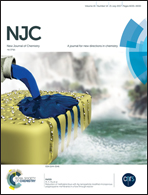Ultrasensitive and label-free detection of creatine based on CdO nanoparticles: a real sample approach
Abstract
Low-dimensional cadmium oxide nanoparticles (CdO NPs) were prepared by a facile wet-chemical method in an alkaline medium with reactant precursors and urea surfactants. The optical, morphological, and structural properties of CdO NPs were characterized in detail using FT-IR, UV-Vis, FESEM, XEDS, XPS, TEM and XRD techniques. A glassy carbon electrode (GCE, surface area = 0.0316 cm2) was fabricated with a thin-layer of CdO NPs using a conducting binder, nafion, for the development of selective and sensitive label-free creatine (Ctr) sensors. Electrochemical investigation along with determination of the sensitivity, limit of detection (LOD), linear dynamic range (LDR) and long-term stability towards Ctr was performed by an electrochemical approach. The calibration curve was found to be linear in a wide range of Crt concentrations (0.1 nM–0.1 M). The sensitivity (1.90 μA μM−1 cm−2) and LDR were calculated from the calibration curve and were also found to be linear (R2 = 0.9297). The signal to noise ratio was ∼3, and the LOD was calculated and found to be 50.0 ± 0.1 pM. It is an enzyme-free organized route for the development of sensors based on low-dimensional CdO NP embedded GCE using electrochemical oxidation phenomena. To the best of our knowledge, this is the first report on the detection of highly sensitive Ctr using a CdO NP/GCE by an I–V method. A pioneering development of Ctr sensitive sensors using CdO NPs by a facile and reliable I–V method is suggested for important sensor applications of less useful materials in biological systems.



 Please wait while we load your content...
Please wait while we load your content...